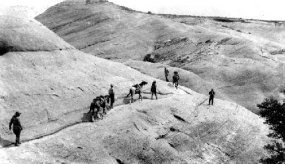|
The Cummings-Douglass Expedition Rainbow Bridge was undoubtedly known to local Indian tribes of the area, both prehistoric and historic. There is also evidence to support the likelihood that a few cowboys and prospectors had also stumbled across the span in the course of their wanderings. Yet, it was not until 1909 that Rainbow Bridge was "discovered" and publicized to the outside world. That discovery was shared by two veteran Southwestern scholars--Dr. Byron Cummings and William B. Douglass--who were united, albeit briefly, by John Wetherill, a famous Southwestern trader and explorer in his own right. 
NPS Archives Stories of a legendary bridge of stone had been heard in several circles for a number of years. John Wetherill, along with his wife Louisa, had heard tales of the bridge from Navajo people while operating their trading post in Oljato. The Wetherills passed along this information to University of Utah archeologist Dr. Byron Cummings, who was conducting expeditions in the area. Meanwhile, William B. Douglass, Examiner of Surveys under the General Land Office, who was completing a survey of the newly created Natural Bridges National Monument also heard the story of a marvelous natural bridge. He informed his superiors who instructed him to attempt to locate the bridge. Thus, the "race" began. There had apparently been friction between Cummings and Douglass in the past. Indeed, at the time when both parties were preparing expeditions to search for the bridge, Douglass was also attempting to have Cummings' permit to excavate archeological sites revoked. John Wetherill, who was organizing the Cummings expedition, was placed in the position of being a mediator for the two groups. After much discussion and at least one false start, the two rivals agreed to combine their resources. 
NPS archives On August 11, 1909, the group began their trek to the bridge. They were guided by Ute Mountain Ute Jim Mike, a member of the Douglass party who had supposedly heard about the bridge from the Navajos. Along the way they were to meet up with Paiute Nasja Begay, another local who knew the route to the bridge. Finally, late in the afternoon of August 14, the weary riders reached their goal. The rivalry between Cummings and Douglass had not lessened during the journey, however, and both men spurred their horses in an attempt to be the first white man to ride under the bridge. John Wetherill saw what was happening and, being closer to the bridge, went on ahead and rode under the span. It is unclear if Wetherill was motivated by diplomacy or irritation, but his actions did defuse this particular point of contention between Cummings and Douglass. The two explorers rode side-by-side under the bridge--after Wetherill. |
Last updated: June 5, 2015
